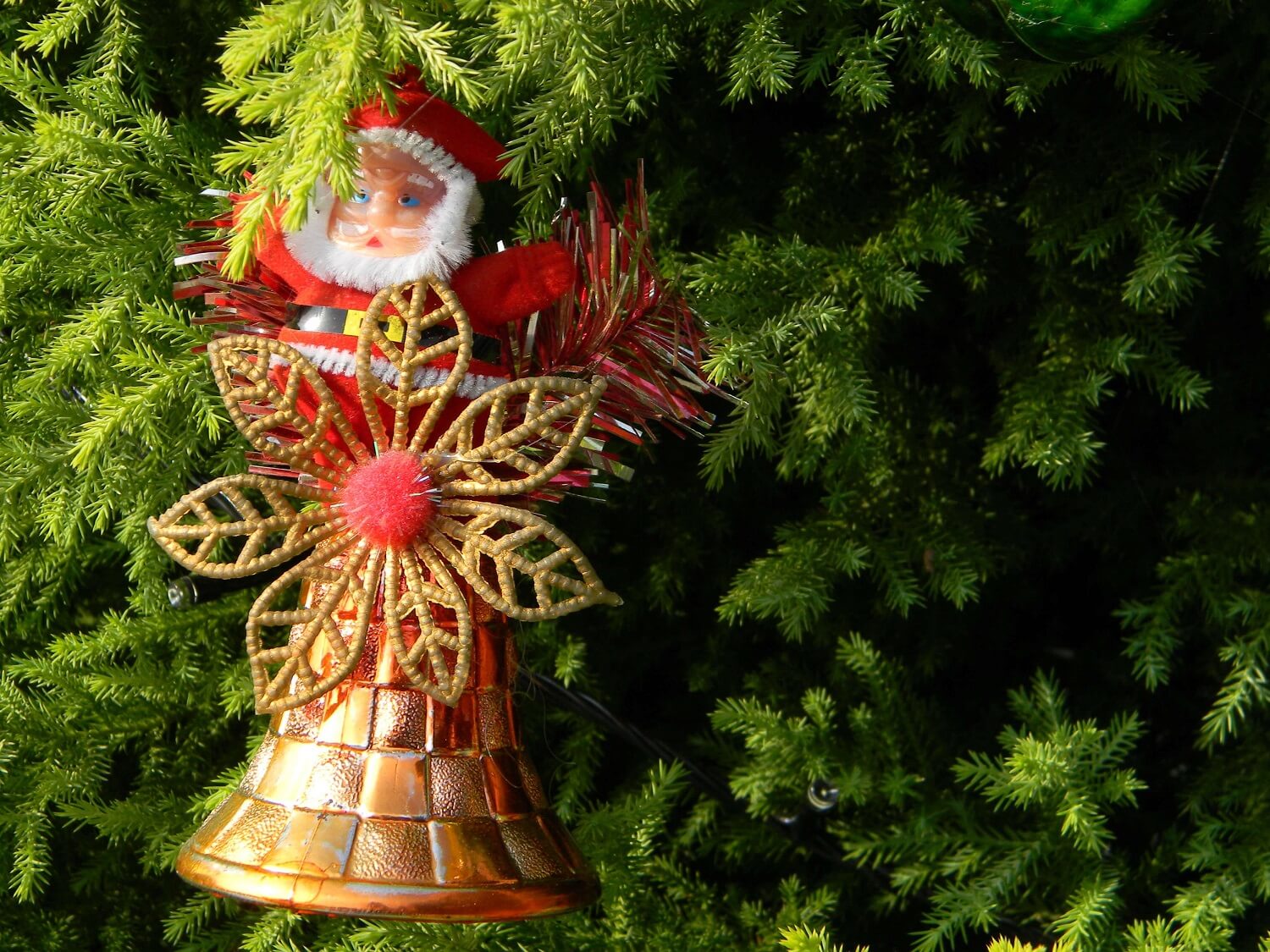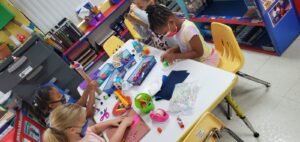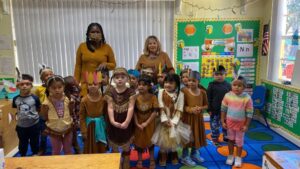The Christmas season is a beautiful time for preschoolers to discover the magic behind the decorations and symbols that fill our homes and streets. Beyond the fun and festivity, each symbol holds a special meaning that teaches us important things about kindness, togetherness, and hope.
Delving into these symbols with young learners becomes a gateway to understanding the essence and significance of Christmas. Let’s embark on a journey uncovering 15 enchanting Christmas symbols and their importance in igniting the spirit of wonder and creativity in kids.
15 Christmas Symbols and Their Meanings
Santa Claus
Santa Claus, also known as St. Nicholas, originated from the story of a kind-hearted bishop who secretly helped those in need by giving gifts. Over time, his tale evolved into the beloved figure we know today, symbolizing generosity and spreading joy by delivering gifts to children worldwide on Christmas Eve.
Santa embodies the spirit of giving, teaching children the joy of sharing and kindness to all. Exploring his cheerful persona, red suit, and goodwill spreads warmth and excitement among preschoolers.
Christmas Tree
The Christmas tree tradition is believed to have roots in Germany in the 16th century. It symbolizes life and renewal, with evergreen trees representing everlasting life. Decorating the tree with lights and ornaments became famous for celebrating the holiday season and bringing families together.
Decorating the Christmas tree is a fun activity that promotes teamwork and creativity among preschoolers. It creates a sense of togetherness and builds anticipation for the holiday season.
Lights
The use of lights during Christmas dates back centuries, initially representing the light of Christ and later evolving into a symbol of hope and joy during the darkest days of winter.
Their twinkling presence illuminates homes and streets, spreading warmth and cheer. For preschoolers, these bright lights signify the magic and brightness of the season, reinforcing the idea that even small sources of light can dispel darkness.
Wreath
Wreaths have ancient origins, symbolizing eternity and unity. The circular shape represents unending love within families and communities. They were traditionally crafted using evergreen branches, signifying everlasting life even in the cold winter.
Crafting wreaths encourages preschoolers to understand the concept of unity and everlasting love within families and friendships, fostering a sense of belonging and community.
Star
The star atop the Christmas tree or in nativity scenes symbolizes the Star of Bethlehem, guiding the three wise men to the birthplace of Jesus. It represents hope, light, and the promise of new beginnings, emphasizing the significance of Christ’s birth.
The star symbolizes hope and guidance. It helps preschoolers understand that even in uncertain times, a guiding light always leads to brighter days.
Bells
Bells have been used in Christmas celebrations for their joyful sound, signifying the announcement of the season’s arrival and the joyous spirit of celebration. Their ringing symbolizes unity and togetherness.
Bells create a festive atmosphere and introduce preschoolers to the concept of celebration. Their cheerful sound sparks excitement and anticipation for joyful gatherings.
Christmas Ornaments:
Ornaments adorn the Christmas tree, each carrying its own story and significance. Originating from 17th-century Germany, these decorations evolved from simple fruits and nuts to beautifully crafted ornaments, symbolizing cherished memories and traditions.
Creating ornaments allows preschoolers to express themselves creatively. Each ornament holds personal significance, promoting storytelling and sharing special memories.
Candy Cane
Legend suggests that candy canes originated in Germany, shaped like shepherd’s crooks to represent the staff of shepherds who visited the baby Jesus. Its red and white stripes symbolize purity and the blood of Christ, while its shape reflects the letter ‘J’ for Jesus and the shepherd’s staff.
The candy cane’s sweetness mirrors the joy of Christmas. For preschoolers, its shape and colors introduce the tale of generosity and the season’s sweetness.
Reindeer
Reindeer became associated with Christmas through the story of Santa Claus. The legend of Santa’s flying reindeer originates from Scandinavian folklore, where these magical creatures pull Santa’s sleigh on his worldwide gift-giving journey.
Reindeer bring magic to Santa’s journey, capturing children’s imaginations. Learning about these enchanting creatures sparks excitement and wonder.
Angel
Angels play a significant role in the Nativity story, representing messengers of peace and goodwill. They symbolize the announcement of Jesus’ birth and spread messages of hope, protection, and harmony.
Angels represent peace and goodwill. Understanding their significance helps preschoolers grasp the importance of kindness and spreading happiness.
Stockings
The tradition of hanging stockings originates from the story of St. Nicholas, who is said to have gifted gold to a low-income family by dropping it down their chimney, which landed in a stocking hung by the fire to dry.
Hanging stockings builds excitement and teaches preschoolers about gratitude and the joy of receiving surprises. It instills a sense of appreciation for small acts of kindness.
The Colors Red and Green
Red symbolizes love and sacrifice, often associated with the blood of Jesus and the passion shared among family and friends. Green represents life, renewal, and nature’s resilience, signifying hope and the everlasting cycle of life, even amid winter.
Red and green colors stimulate preschoolers’ senses and create a festive atmosphere. Exploring these colors fosters creativity and helps in understanding their symbolism.
Gingerbread Men
Gingerbread cookies have a long history, originating in Europe during the Middle Ages. They were often shaped into figures, including men and women, and became associated with Christmas traditions, representing playful and delightful treats enjoyed during the holiday season.
Baking and decorating gingerbread men involve sensory activities that encouraging fine motor skills and creativity. It introduces preschoolers to the joy of playful traditions.
Dove
The dove is a universal symbol of peace and purity. In the Christian tradition, it symbolizes the Holy Spirit and is often associated with the Nativity, representing messages of harmony, hope, and divine blessings.
The dove’s symbolism introduces preschoolers to peace and tranquility, encouraging empathy and harmony in their interactions with others.
Holly
With its vibrant red berries and green leaves, Holly has ancient pagan origins, symbolizing hope, protection, and everlasting life. It was later incorporated into Christian traditions, representing Christ’s crown of thorns, his bloodshed, and the promise of new life through his resurrection.
Holly’s vibrant appearance engages preschoolers’ curiosity about nature. Exploring its symbolism fosters appreciation for nature’s beauty and the importance of hope and resilience.
These symbols, deeply rooted in history and tradition, carry rich stories and meanings that add depth and significance to the festive season. Exploring these Christmas symbols helps us learn about more than just decorations. They teach us about being kind, thankful, and hopeful.
These symbols make Christmas a time full of happiness and give us unique ways to show love to each other. We carry these joyful feelings in our hearts as we learn and celebrate, making the holiday season even more magical.




